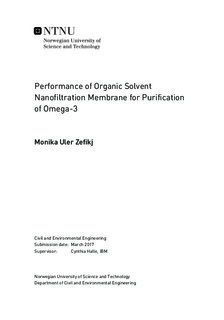| dc.description.abstract | In this master thesis, the performance of organic solvent nanofiltration membrane for purification of Omega-3 is studied. The aim was to contribute to the improvement of the production process of a Norwegian company producing fish oil using membrane technology by enhancing the product quality. The behavior of two types of membranes, polymeric and ceramic, was tested in order to determine which gives an optimal range of rejection of phospholipids and triglycerides contained in the roe extract obtained from the production process.
The nanofiltration separation pressure-driven process was applied, using cross-flow filtration regime at two different pressures of 5 bar and 40 bar. The organic solvent used for defining the membrane performance during the experiment is based on three components, ethanol, water and dry matter from roe extract in different weight percentages. The membrane rejection is analyzed based on samples taken during the screening phase using ultra high performance liquid chromatography (UHPLC) technique as the fraction of material removed from the permeate stream.
The approaches of presenting the results are focused on the rejection percentage, standard deviation and distribution, as well as their interconnection and correlation with other parameters, such as specific flux, time, feed condition. It was observed that DuraMem 200 obtained the highest rejection for each feed type, and the rejection level was decreasing together with the molecular weight cut off (MWCO) of the membrane. The standard deviation of the rejection did not follow any defined trend, and it varied with the weight change of ethanol/ water in the feed. The results analysis showed that the specific flux decreased in time; and lowest flux was correlated with higher rejection percentage. By comparing the rejection results for the tests with the two different pressures, it was observed that the increase in pressure which is applied onto the membrane did not affect the level of rejection.
The conclusions based on the obtained results for the membrane performance give directions and contribute to the selection of the right membrane type and operating conditions, which offer the opportunity to transform a batch process into semi-continuous batch process that can be more easily automated and can be more compact and productive than a traditional system used in the abovementioned fish oil production company. | |

